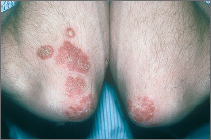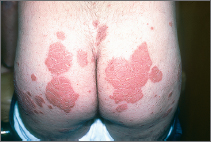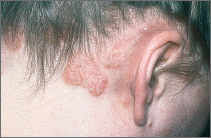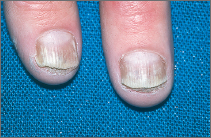Psoriasis on the elbows
About 30% of people with psoriasis have a family history of the condition.
Psoriasis most frequently begins in the second or third decade of life, but it can first be seen in infants or in elderly persons.
The exact cause is unknown; however, we do know that psoriatic lesions (spots) result from an increase in epidermal cell division.
Psoriasis on the buttocks
What does it look like, and where on the body does psoriasis occur?
Thickened, reddened, silvery or whitish, scaly patches can vary from only a few small bumps known as papules to larger plaques that cover large areas of the body.
Psoriasis tends to be remarkably symmetric. (It tends to look almost the same on both sides of the body.)
Psoriasis is most commonly located on the:
Body folds: the underarms, under the breasts, the anus and genital region, and the groin. This body fold type of psoriasis is referred to as inverse psoriasis.
Trunk. Lesions may be small, guttate (teardrop-shaped), or large plaques.
Nails. Involvement of nails is very common in patients with psoriasis.
Psoriasis on the scalp
Psoriasis generally is symptom-free but can become quite itchy and uncomfortable, particularly during acute flare-ups or when it involves the scalp or skin fold regions.
Psoriasis affecting the nails
What is the usual course of psoriasis?
Psoriasis has an unpredictable, waxing and waning course. It has no known cure.
In its mildest forms, psoriasis is an incidental finding. It may consist of nail pitting or mildly red, scaly patches on the elbows or knees.
During episodes of physical illness or pregnancy, psoriasis may worsen or suddenly clear.
The condition tends to improve during the summer and worsen during the colder times of the year. This fluctuation is probably a result of the positive influence of sunlight on psoriasis.
Dermatologists can usually easily recognize it by simply examining the skin.
Other helpful diagnostic features include family history of psoriasis.
If necessary, other tests, such as a skin biopsy or fungal examinations, can be performed to rule out other conditions.
Topical corticosteroids. The use of a very potent topical steroid applied for a limited period, followed by a less-potent topical steroid for maintenance, has become a popular method for treating psoriasis.
Topical immunomodulators such as Protopic ointment and Elidel cream are sometimes used to treat inverse psoriasis.
Other topical treatments. Topical retinoids and topical tar preparations are less often used.
Natural sunlight sometimes slows the growth of psoriasis. People with psoriasis all over their bodies may be treated with light boxes that expose most of their body to ultraviolet light.
Ultraviolet light therapy plus oral treatments is used when a person who has psoriasis is not responding to topical therapies or ultraviolet light treatment alone.
Newer approaches to psoriasis therapy. There are many new biologic agents that are currently available for the treatment of psoriasis and psoriatic arthritis.
The National Psoriasis Foundation provides information about the latest treatments for psoriasis, educational pamphlets, and information about self-help and discussion groups (800-723-9166).



